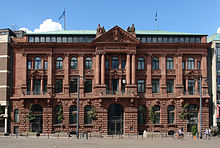
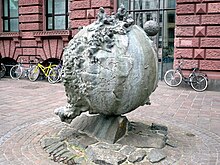
The Deutsche Bank building (German: Deutsche Bank am Domshof) on Domshof Square in the centre of Bremen, Germany, was completed in 1891 in a Historicist style by the architects Wilhelm Martens and Friedrich Wilhelm Rauschenberg. [1]


The Deutsche Bank building (German: Deutsche Bank am Domshof) on Domshof Square in the centre of Bremen, Germany, was completed in 1891 in a Historicist style by the architects Wilhelm Martens and Friedrich Wilhelm Rauschenberg. [1]
The imposing building located at No. 25 Domshof was designed by Wilhelm Martens (1842–1910) from Berlin and the Bremen architect Friedrich Wilhelm Rauschenberg (1853–1935). The building was for the Deutsche Bank which had been founded in 1870 in Berlin with a major aim of supporting foreign trade with Germany. [2] The bank's building is built in red sandstone from the Main Valley in a currently popular Historicist style derived from Italian 16th-century practice, in which colossal Ionic pilasters link two main floors above a high rusticated basement storey; the expanded central entrance bay is pedimented and the end bays are slightly emphasized and lightly projecting.
Martens, the house architect of Deutsche Bank, Berlin, was considered a specialist in bank design. He also drew up plans for the Sparkasse building on Bremen's Am Brill which was completed in 1906. Rauchenberg, who above all was responsible for overseeing the actual construction of the building, is remembered for his many residential and commercial buildings in the city, mainly designed in the Neo-Renaissance style. The Deutsche Bank am Domshof has been a listed building since 1981. [1] [3]
In connection with the construction of the Domshof Passage from 1996 to 1999, the bank building was modernized by the Bremen architects Harm Haslob, Peter Hartlich and Jens Kruse. The passage is a shopping arcade with sixteen shops which allows visitors to travel to the Katherinenpassage which was built less than ten years before. [4]
The building faces the Domshof, the market square, in Bremen and just in front of the bank is a sculpture based on a model of the world. Titled Unser Planet (Our Planet), it was made by the German sculptor Bernd Altenstein. [5]
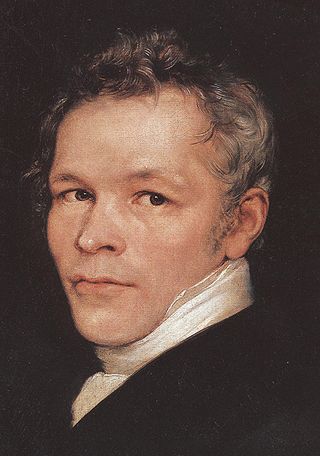
Karl Friedrich Schinkel was a Prussian architect, city planner and painter who also designed furniture and stage sets. Schinkel was one of the most prominent architects of Germany and designed both neoclassical and neogothic buildings. His most famous buildings are found in and around Berlin.

The architecture of Germany has a long, rich and diverse history. Every major European style from Roman to Postmodern is represented, including renowned examples of Carolingian, Romanesque, Gothic, Renaissance, Baroque, Classical, Modern and International Style architecture.

The term Brick Expressionism describes a specific variant of Expressionist architecture that uses bricks, tiles or clinker bricks as the main visible building material. Buildings in the style were erected mostly in the 1920s, primarily in Germany and the Netherlands, where the style was created.
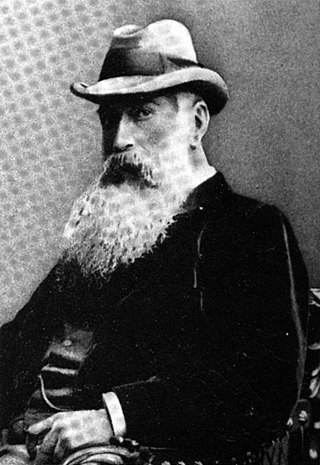
Johann Georg Poppe, often called Johannes Poppe by English-speaking writers, was a prominent architect in Bremen during the German Gründerzeit and an influential interior designer of ocean liners for the Norddeutscher Lloyd. He worked in an eclectic mixture of historical revival styles sometimes called "Bremen Baroque".

Karstadt in Bremen is the largest department store in Bremen. It is located on Obernstrasse and Sögestrasse, in the old town in the city centre. Completed in 1932, the building was listed in 2010 as a notable example of department store architecture in the interwar period.

Haus der Stadtsparkasse is a Rococo landmark on the "Marktplatz" in Bremen, Germany. It was completed in the 1950s combining the historic front gable from another site with the more recent architecture of the remainder of the building.
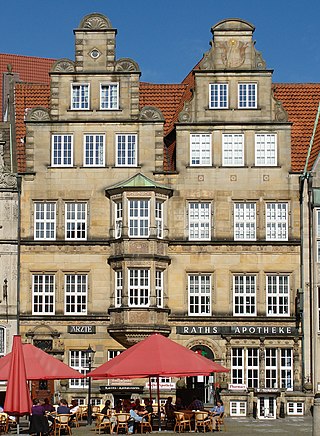
The Raths-Apotheke is a listed building on the Market Square (Marktplatz) in Bremen, Germany. After suffering war damage, the building was restored with two gables in the Neobaroque style in 1958, re-establishing the square's sequence of gabled buildings dating from the 1820s.

The New Town Hall has stood on the Domshof in the centre of Bremen, Germany since 1913. Located behind the Unser-Lieben-Frauen-Kirchhof cemetery, it is adjacent to the older section of the Town Hall with which it forms a harmonious ensemble. Among its sumptuous rooms decorated with local artefacts, the New Town Hall houses the Senate Chamber used by the Senate for its regular meetings and the Great Hall, a venue for official receptions. In 2004, Bremen Town Hall was listed as a UNESCO World Heritage Site, together with the Roland of Bremen, because of its outstanding architecture and testimony to the development of civic autonomy during the Holy Roman Empire.
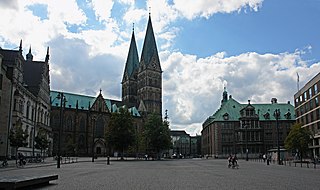
The Domshof is a town square in Bremen, north of the cathedral and the Marktplatz. The Domshof is used for markets as well as larger outdoor events, particularly May Day demonstrations.
The Bremen Exchange in Bremen was one of the eight German Regional stock exchanges until 2007. In 2000 it ceased to use the Open outcry method and in 2007 the last operative units were closed. The property of exchange's holding company went to the newly established Foundation of the Bremen Stock Exchange, a non-profit organisation which is intended to benefit scholarship, research, and culture.
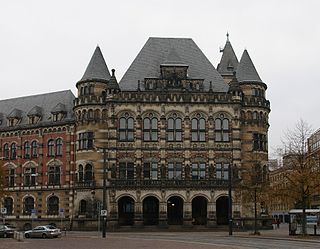
The Landgericht Bremen is the courthouse of the State of Bremen on the Domsheide in the old town of Bremen, Germany. It was built in the late 19th century in the French Renaissance style and completed in 1906. It has been a listed building since 1992. In addition to the judicial services of the regional court, the building houses sections of the Public Prosecutor's department (Staatsanwaltschaft) and of the district court (Amtsgericht).
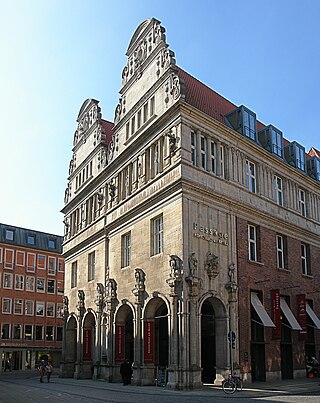
The Kontorhaus am Markt in Bremen is a historical building in the city centre of Bremen. Today, it is used as a shopping mall. It is situated at the Bremer Marktplatz between three streets: Langenstrasse 2/8, Stintbruecke 1 and Bredenstrasse 13.

The Essighaus was an impressive gabled town house in the old town of Bremen in northern Germany. One of the city's finest examples of Renaissance architecture, it was almost completely destroyed by bombing in 1943. The entrance flanked by projecting bay windows is the only part of the building which has been restored.

Viertel is a centrally located neighborhood in the city of Bremen, Germany. It lies east of the old town on the border between two different administrative subdistricts: Ostertor and Steintor. It is currently recognised for its many cafés, restaurants, and boutique boutiques.

Jacob Ephraim Polzin was a German Neoclassical architect active in Bremen, Germany.

The Langenstraße is a historical street in the old town of Bremen in the north of Germany. First mentioned in 1234, it is one of Bremen's oldest streets and one of the most important for the city's merchants. It no doubt originated at the time when the first settlements grew up on the north bank of the Balge. It runs west from the Marktplatz parallel to the River Weser over Bürgermeister-Smidt-Straße to Geeren. Many of the street's historic buildings were seriously damaged during aerial bombings in the Second World War but were carefully reconstructed in the postwar period.
Friedrich Wilhelm Rauschenberg was a German architect active in Bremen, Germany.

Hans Grisebach was a German architect whose buildings provided a backdrop for many celebrities from the arts world.

Bremer Bank was a fully owned subsidiary of Dresdner Bank with branches in Bremen's districts Mitte, Neustadt, Utbremen, and Vegesack. The branches in Bremerhaven were labeled as Dresdner Bank.

Friedrich Maximilian Thiersch, after 1897 Ritter von Thiersch, was a German architect and painter in the late Historicist style.